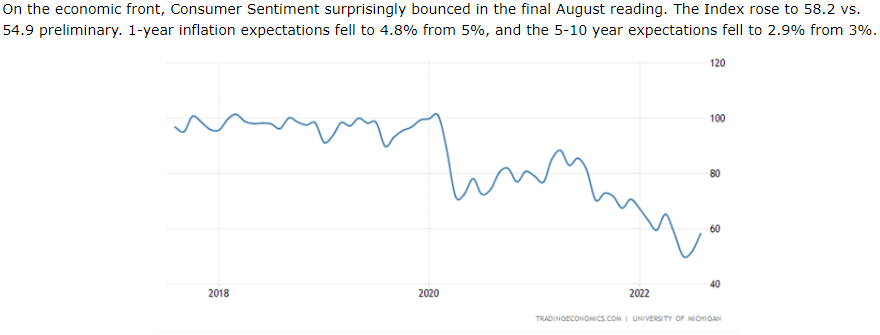Jackson Hole, Wyoming is a beautiful sun-drenched city in the Summer, and cold (but great skiing) in the Winter.
August offers low humidity with warm pleasant mountain weather during the day, then comfortably cooler nights.
It reminds me of another high-altitude city called Santa Fe where one of our offices resides. Both cities have great weather this time of year.
They are very livable smaller cities, but both are getting expensive to live in. However, that is happening everywhere in the US. And that is big part of the inflation story that the Fed is wrestling with.
Inflation was the focus of the Fed’s annual Jackson Hole Economic Policy Symposium that took place this past week.
Leaders from all around the world attend to participate in group discussions, and listen to the Fed’s latest research and prognostications.
Attendees include CEO’s from various industries, portfolio managers from the largest investment firms, family offices, and hedge funds.
Economic reporters, well respected leaders and analysts, current and past Fed governors, and TV commentators all provide play by play analysis of the whole event.
The reporting centers around the economic outlook, interest rates, employment, social issues, federal and consumer debt, and everything in between.
Surprisingly, many participants were more hawkish than had been expected
One of the most outspoken Governors was James Bullard from the St. Louis Fed.
He has been very hawkish for quite some time. He believes that inflation is out of control and needs to be addressed NOW. He’s adamantly, suggesting that the Fed Committee front end load rate hikes (raise rates quickly and higher than expectations) to fight inflation.
The market shook many of these comments off during the weeks leading up to this week’s speech.
But had they become relaxed?
Jerome Powell, the current Fed Reserve Chairman, addressed the crowd Friday morning.
The title of this year’s speech was “Reassessing Constraints on the Economy and Policy,” an economic policy symposium sponsored by the Federal Reserve Bank of Kansas City, Jackson Hole, Wyoming
This speech is so important because it provides a roadmap for what course of action, if any, it may take in the near future.
We have lived in a long period of loose monetary policy, with inflation well under control (2.0%), we saw rates at the lowest they had ever been historically. But coming out of the pandemic, several rescue monetary giveaways, global supply issues and a hostile incursion in Ukraine, things have changed rather dramatically. Inflation is the number ONE problem these days around the world.
The Fed’s discussion of its stance on inflation is reason (among others) that most active traders and investors, along with financial firms of all size and stature were focused on the Jackson Hole Symposium this week.
Also, since the symposium is held late in the summer, trading volume is low leading up to the speech. It can explode positively or negatively, shortly thereafter, if anything of importance is discussed.
Such was the case this past Friday
Chairman Powell, in a brief early morning speech that lasted all of 10 minutes, said that the Central Bank’s job on lowering inflation is not done, suggesting that the Fed will continue to aggressively raise interest rates to cool the economy.
“We will keep at it until we are confident the job is done,” Powell said in his remarks delivered on Friday.
“While the lower inflation readings for July are welcome, a single month’s improvement falls far short of what the Committee will need to see before we are confident that inflation is moving down,” Powell said.
Powell said more rate hikes will be needed, with “another unusually large” increase still on the table for the Fed’s next meeting in September. The Fed chair reiterated that “at some point,” the Fed will move to slow the pace of its price increases.
“In current circumstances, with inflation running far above 2 percent and the labor market extremely tight, estimates of longer-run neutral are not a place to stop or pause,” Powell said Friday.
Action Jackson struck again! The Dow ended the day down 1,000 points and the S&P was down worse with a loss of 3.37%. Only 5 of the 500 stocks in the S&P 500 were positive at the end of the day Friday. It was a brutal sell off!
“Only hawks get to go to central bank heaven”
Robert D. McTeer Jr. served as the eleventh president of the Federal Reserve Bank of Dallas from February 1, 1991, to November 4, 2004
Additional Pain Ahead
The media quickly met Chairman Powell’s’ concluding remarks from his speech with the following headlines: “The Chairman’s Speech implied that Americans must endure more pain before inflation is under control”.
After Chairman Powell’s comments in July indicating a potential “pause,” most Americans may be in for an extended period of pain, both in rising rates, higher food and energy prices and a potential slowdown in their businesses.
Reminds me of a fortune cookie message someone recently sent me (see front and back below):

Inflation Data
Inflation data on Friday morning showed prices in America rose by 6.3% on a year-over-year basis in July, a notch down from the 6.8% pace measured in June. When stripping out food and energy, the Personal Consumption Expenditures Index showed prices rising by 4.6% compared to a year ago — still well above the Fed’s target of 2%. See chart below:

The central bank has delivered four consecutive interest rate hikes over the last six months, moving in June and July to raise rates by 0.75%, the Fed's largest moves since 1994. By raising borrowing costs, the Fed hopes to dampen demand by making home buying, business loans, and other types of credit more expensive.
Rates on the 10-year rose slightly and the yield curve remains inverted. This alone is projecting an economic slowdown. Risk assets brutally sold off Friday and closed on the low of the day. Volume was heavy indicating that many traders stepped in either to sell their stocks or to put on new shorts as they believe this may be the start of a new leg down.
Consumer sentiment ticked up slightly in the final August reading. While this (and inflation coming down slightly) would have been considered good news, it was the hawkish message delivered by the Fed Chairman that took the air out of the market. Chart below (courtesy of Charles Payne):

An Earnings Update
Over the last few months, we have stressed the BIG 3. Earnings, Interest rates and Inflation. We have already covered where interest rates are likely headed (up) and Inflation data still shows inflation running well above average.
These two (or the three) being problematic will continue to put pressure on the stock market by revaluing stock market prices. This will affect some industries more than others.
The third factor (of the Big 3) is earnings. A reduction in earnings might be a triple whammy. Interestingly enough (thanks to Mish) we have a clearer picture of Q2 earnings of 2022 and how they have affected the stock market (S&P 500) thus far.
With 96% of companies reported, S&P 500 operating earnings are down 9% year-over-year, the largest YoY decline we’ve seen since Q2 2020. Earnings during the quarter were down 17% from their peak in Q4 2021 and the S&P 500 is currently down 15% YTD.
Folks, there will be considerable pressure on companies due to higher borrowing costs, higher operating costs, a slowdown of consumer purchasing and stock multiples contracting.
Additionally, due to these factors and more, companies may reduce or stop corporate stock buybacks which have played a big part in stock price appreciation the past few years. Let us repeat our 2022 mantra, yet again. Please be careful and try not to “chase” opportunity until it is a good time to do so.
Ways to Protect Your Investments:
If you review any of our previous weekly Market Outlook articles, we have maintained a cautious tone and recommended the following (which we repeat yet again):
- Watch for bullish and bearish phases of Mish’s Modern Family. You will notice that we have been in a major market bearish phase since early 2022. While we have been above the 50-day moving average, we have not, as of yet, gotten above the 200-day moving average in most of the indices. Watch these important levels for market health.
- Watch our Risk Gauges and review the Big View information below. It always gives you an in-depth view of the market.
- Buy some protective hedges. This can be outright puts on stocks you own or the major indices. You might also consider selling some call options for additional income on some of your holdings.
- Move to cash. If you have an Advisor, suggest that they take a more conservative approach and raise some cash. If they tell you that they cannot, get another Advisor or call us.
- Diversify, diversify, and diversify. Many of our quant based algo strategies have been invested this year in energy plays (currently TAN and UNG), as intermittently utilized inverse funds to take advantage of rising interest rates or falling stock prices.
- Follow Mish and her Ultimate Trading Portfolio. She does a great job of getting out of the way when the knife begins to fall. She is up on the year and has been using cash judiciously to avoid putting money at risk.
- Don’t watch the markets. If you are emotionally too tied to the daily moves, call or email us and let us help you. Perhaps we could even demonstrate how you could implement a blended strategy to smooth out the ride.
- Enjoy the remainder of the summer. One of our founder’s (Geoff Bysshe) always says that negative markets are exciting because we know that eventually we are going to get into good markets, and we are setting up for amazing opportunities right now.
Here are additional observations from Big View
Risk-Off
- All 4 major US Indices broke down hard, especially on Friday, potentially giving up the past month’s gains and now looking to find support around the 50-day moving average. (-)
- Volume Patterns have crumbled across the board for major US Indices, with all ending the week with a Distribution day on Friday, as well as more Distribution than Accumulation days over the past 2 weeks. (-)
- This week's only positive sector was Energy (XLE) +4.3% amongst mounting geopolitical stress and inflationary pressures. (-)
- The clear losers this week were European Country ETFs (EWD, EWG, EWI, EWO), while the hotspot was once again oil-based Energy plays including USO, XOP, and OIH followed by Soft Commodities which were led by Corn (CORN). (-)
- On a shorter-term basis, market internals are breaking down further for indices according to the 10-day Advance / Decline ratio. (-)
- The New High / New Low ratio is breaking down across the board, a bearish indication. (-)
- Risk Gauges have deteriorated enough to now be showing a Risk-Off scenario in the market. (-)
- Looking at 1 month vs 3 month volatility (VIX / VXV), sentiment broke down this week. (-)
- Both ProShares VIXY and Cash Volatility (VIX.X) broke to the upside this week after an extended selloff. (-)
- The number of stocks within the S&P 500 and Russell 2000 Indices above their respective 50 and 200 day moving averages continues to break down. (-)
- The Yield Curve is inverting even further, a Recessionary indication. (-)
- Value stocks (VTV) continue to outperform Growth stocks (VUG) on a relative basis, but did not weather the storm on Friday and sold off with everything else. (-)
- There was a failure across the board this week for Mish’s Modern Family, with the 2 biggest losers also being the most speculative members, Semiconductors (SMH) and Biotechnology (IBB) both closing below their 50-day moving averages. (-)
- Emerging Markets (EEM) which is heavy in both China (FXI) and Latin America (ILF) is now outperforming both Established Markets (EFA) and US Equities on a relative basis according to the TriplePlay indicator. (-)
- Agriculture (DBA) was very strong this week and totally outperformed the S&P 500, showing inflationary pressures. (-)
- Both Gold (GLD) and Oil (USO) are now relatively outperforming US Equities on a daily basis according to TriplePlay. (-)
- The US Dollar (UUP) is at an inflection point where if it clears recent highs it could run another 5-10%, while if it doesn’t hold next week it could correct all the way back down to its 50-day moving average as support. (-)
Neutral
- Although price broke down hard on Friday for the S&P 500 or Nasdaq Composite, the McClellan Oscillator did not make lower lows yet for either index, a potential divergence in market internals. (=)
- Despite a strong week for Oil-based energy plays, USO actually closed below its 50-day moving average and ended the week with a red day on Friday. (=)
